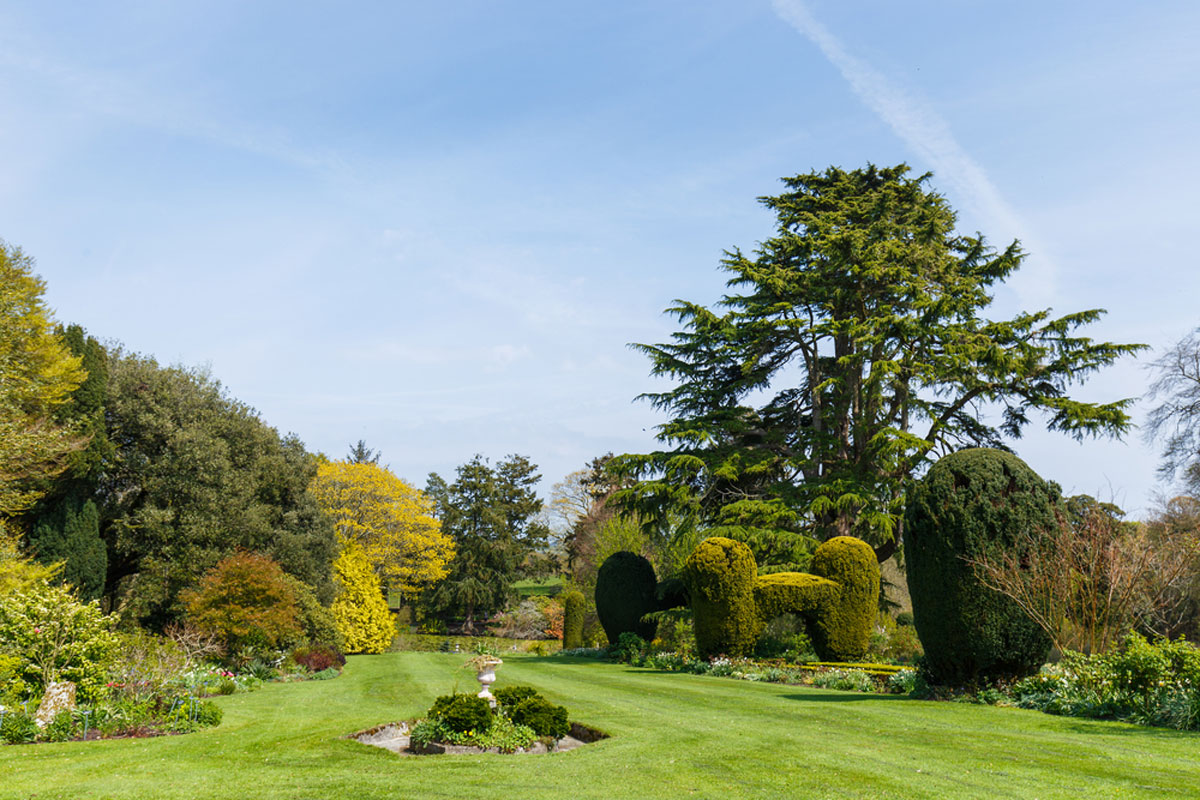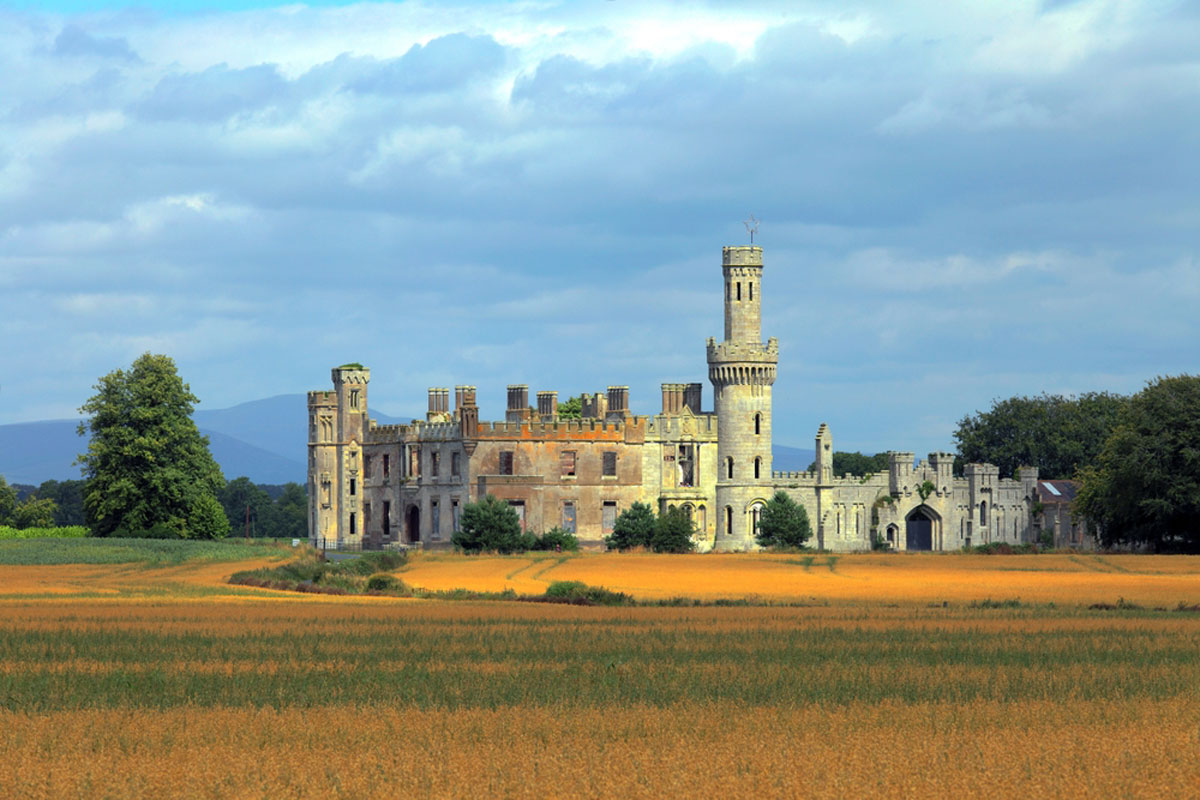An Introduction to Altamont Gardens
Nestled in the picturesque countryside of County Carlow, Altamont Gardens is often described as “the jewel in Ireland’s gardening crown.” Spanning 100 acres, this enchanting estate is celebrated for its diverse plant life, beautifully landscaped gardens, and peaceful atmosphere, making it one of Ireland’s most treasured horticultural destinations.
The gardens blend formal and informal landscaping, featuring a stunning mix of manicured lawns, romantic woodlands, and vibrant floral displays. They are renowned for their seasonal beauty, particularly in spring, when the snowdrop collection—one of the most extensive in Ireland—creates a breathtaking display. Later in the year, bluebells, rhododendrons, and roses add a burst of color, delighting visitors at every turn.
Beyond the flowers, Altamont Gardens offers more than just visual beauty. Meandering pathways lead guests through tranquil lakeside walks, shaded woodlands, and open meadows, providing a perfect setting for relaxation and exploration. The estate’s rich history, carefully preserved landscapes, and commitment to biodiversity make it a haven for nature lovers and garden enthusiasts alike.
Seasonal Highlights and Floral Wonders of Altamont Gardens
One of the most captivating aspects of Altamont Gardens is its ever-changing beauty throughout the seasons. Each time of year brings new colors, scents, and sights, making the gardens a year-round delight for visitors.
Spring: A Snowdrop Spectacle
Altamont Gardens is world-famous for its snowdrop collection, which creates a magical display in January and February. The gardens host an impressive variety of snowdrops (Galanthus), with over 100 named cultivars, including rare and unusual varieties. These delicate white blooms carpet the woodland floor, marking the first sign of spring’s arrival.
As spring progresses, the gardens come alive with:
- Daffodils and crocuses adding bursts of yellow and purple
- Bluebells in April and May, transforming the woodlands into a sea of blue
- Magnolias, camellias, and rhododendrons adding vibrant hues to the landscape
Summer: A Riot of Color
In the summer months, Altamont Gardens reaches its peak in terms of color and fragrance. The walled garden and herbaceous borders burst into bloom with:
- Roses, including classic and heritage varieties
- Lavender, lilies, and foxgloves, filling the air with sweet scents
- Exotic plants and ornamental grasses, adding texture and movement
The lake and river walkways are particularly beautiful in summer, offering cool shaded retreats amidst the warm weather.
Autumn: A Golden Tapestry
As summer fades, Altamont Gardens transforms into a breathtaking autumnal wonderland. The estate is home to a diverse collection of trees, which display stunning shades of red, orange, and gold in September and October.
Key highlights include:
- Japanese maples, with their fiery red foliage
- Beech, oak, and chestnut trees, shedding golden leaves along the pathways
- Autumn perennials and late-blooming flowers, providing the last bursts of color before winter
Winter: A Quiet Beauty
Even in winter, Altamont Gardens retains a serene charm. The sculpted yew hedges, frost-covered woodlands, and reflections on the lake create a tranquil, almost mystical atmosphere. The evergreens, holly, and ivy provide structure and color, while the early snowdrops begin to emerge, hinting at the renewal of spring.
A Garden for All Seasons
Whether visiting for the snowdrops in winter, the bluebells in spring, the roses in summer, or the golden foliage of autumn, Altamont Gardens offers something spectacular in every season. Its carefully curated landscapes and diverse plant life make it a destination worth visiting time and time again.
The History and Heritage of Altamont Gardens
Altamont Gardens is not only a horticultural masterpiece but also a place rich in history and heritage. Over the centuries, the estate has passed through the hands of various owners, each leaving their unique mark on the landscape. From its 18th-century origins to its present-day role as a beloved public garden, Altamont’s story is one of passion, preservation, and dedication to nature.
1. The Origins of Altamont Estate
The estate dates back to the 18th century, when it was designed in the style of a romantic, informal garden, inspired by the grand landscape gardens of Europe. The layout, with its sweeping lawns, meandering paths, and hidden groves, reflects the influence of Georgian and Victorian garden design.
A key feature from this period is the yew walk, a meticulously maintained hedge-lined avenue that adds a sense of grandeur and mystery to the estate. The walk remains one of Altamont’s most iconic and photographed features.
2. The Legacy of Corona North
The most significant influence on Altamont Gardens in modern times came from Corona North, a passionate gardener and conservationist who devoted her life to the estate. Her family purchased Altamont in the 1920s, and after her father’s death, Corona took on the immense task of restoring and expanding the gardens.
Under her care, Altamont evolved into one of Ireland’s finest botanical treasures, with her plant collections drawing visitors from across the world. She introduced:
- Rare and exotic plant species, carefully integrating them into the existing landscape
- A renowned collection of snowdrops, now one of the largest in Ireland
- Improvements to the lake, woodlands, and walled gardens, enhancing their beauty and biodiversity
Corona North dedicated over 50 years to Altamont, ensuring its preservation for future generations. Her deep love for the gardens led her to gift the estate to the Irish State in 1999, ensuring its protection and ongoing maintenance by the Office of Public Works (OPW).
3. A National Treasure Preserved
Today, Altamont Gardens remains a testament to Corona North’s vision and dedication. The OPW continues to maintain and enhance the gardens while preserving their historical integrity. Thanks to public access and guided tours, visitors can still experience the magic of Altamont just as its caretakers intended.
The estate’s heritage and legacy live on, making it not just a beautiful destination but also a place of historical significance in Ireland’s horticultural landscape.
Looking to the Future
While deeply rooted in history, Altamont Gardens continues to evolve, with ongoing efforts to conserve its biodiversity, expand its plant collections, and welcome new generations of nature lovers.
Unique Features and Hidden Gems of Altamont Gardens
Altamont Gardens is a botanical wonderland, offering visitors an enchanting mix of formal gardens, wild woodlands, and tranquil waterscapes. Beyond the seasonal floral displays, the gardens boast historic pathways, hidden corners, and diverse natural habitats, making every visit a new and immersive experience.
1. The Romantic Lake Walk
One of Altamont’s most cherished features is the serene lake, which lies at the heart of the gardens. This man-made lake, created in the 18th century, is framed by mature oak, beech, and chestnut trees, their reflections shimmering in the still waters.
A meandering path leads visitors around the lake, offering picturesque views and moments of peaceful solitude. Stone bridges, rustic benches, and trickling streams enhance the tranquil setting, making it a favorite spot for both photographers and nature lovers.
2. The Ancient Yew Walk
A signature element of Altamont Gardens is the historic yew walk, a magnificent avenue lined with towering yew trees. This dramatic pathway, dating back over 300 years, was carefully designed to create a sense of mystery and grandeur. The dark, towering hedges form a natural tunnel, leading visitors toward the brighter, open spaces of the garden.
It is said that walking through the yew avenue feels like stepping back in time, and it remains one of the most photographed and iconic parts of the estate.
3. The Walled Garden and Arboretum
Tucked away within the estate is the charming walled garden, which houses an array of rare plants, fragrant herbs, and colorful perennials. This Victorian-style garden offers a more structured contrast to the surrounding landscapes, with neat flowerbeds and stone pathways adding to its charm.
Nearby, the arboretum is home to a remarkable collection of rare trees, including Japanese maples, exotic conifers, and towering redwoods. These specimens add a unique dimension to the gardens, showcasing Altamont’s dedication to botanical diversity and conservation.
4. The River Slaney Walk and Wildflower Meadows
For those who enjoy longer nature walks, the gardens offer an extended trail leading down to the River Slaney. This scenic walk takes visitors through ancient woodlands, where native Irish trees like oak, ash, and holly create a lush canopy overhead.
In late spring and summer, the wildflower meadows come to life, attracting butterflies, bees, and birds. This untouched, natural area contrasts beautifully with the formal gardens, offering visitors a chance to experience the biodiversity of Altamont in its most natural state.
5. Hidden Gems and Secret Corners
Part of what makes Altamont Gardens so special is the sense of discovery—hidden gems are scattered throughout the estate, waiting to be found. Some of these include:
- An old ice house, once used to store perishable food before refrigeration
- Moss-covered stone statues, remnants of the estate’s historic past
- A small rockery garden, filled with alpine plants and miniature waterfalls
- Shaded grottoes and secluded benches, perfect for quiet reflection
A Place of Beauty, History, and Tranquility
Altamont Gardens is much more than a horticultural attraction—it is a place of wonder, relaxation, and timeless beauty. Every turn in the path offers a new perspective, a hidden detail, or a breathtaking view, making it a destination that visitors return to again and again.
Visiting Altamont Gardens – Practical Tips and Events
A visit to Altamont Gardens is a truly immersive experience, whether you’re a gardening enthusiast, nature lover, or someone seeking peace and tranquility. With its seasonal beauty, rich history, and diverse landscapes, the gardens offer something for everyone. In this final section, we’ll explore visitor information, events, and tips to help you make the most of your trip.
1. Visitor Information
📍 Location: Altamont Gardens, County Carlow, Ireland
⏰ Opening Hours:
- Open year-round, typically from 9 AM to 4:30 PM (winter) and 9 AM to 7:30 PM (summer)
- Last admission 30 minutes before closing
- Best to check with the Office of Public Works (OPW) for seasonal changes
🎟️ Admission: Free entry (donations appreciated)
🚗 Parking: Available on-site
☕ Facilities:
- Altamont Plant Sales Nursery (specializing in rare and heritage plants)
- Toilets and picnic areas
- Nearby cafés and restaurants in Tullow (about 10 minutes away)
2. Guided Tours and Seasonal Events
For those who want to delve deeper into the gardens’ history and botanical wonders, guided tours are available.
🌿 Guided Tours:
- Typically run from spring to autumn
- Conducted by knowledgeable OPW guides
- Private group tours available upon request
🌸 Special Events & Highlights:
- Snowdrop Month (February) – Celebrating Altamont’s world-famous collection with expert talks and guided walks
- Spring & Summer Plant Fairs – A chance to purchase rare plants and get gardening advice
- Autumn Foliage Walks – Showcasing the garden’s spectacular golden hues
- Christmas Wreath-Making Workshops – Festive craft events using foliage from the gardens
For event updates, it’s best to check the OPW website or follow local tourism boards.
3. Tips for the Best Experience
✅ Best Time to Visit:
- Spring (Feb–May): For snowdrops, bluebells, and rhododendrons
- Summer (June–Aug): For roses, lavender, and water lilies
- Autumn (Sept–Nov): For vibrant foliage and seasonal berries
- Winter (Dec–Jan): For tranquil walks and early snowdrops
👟 What to Bring:
- Comfortable walking shoes – Some paths can be uneven or damp
- Camera or smartphone – The gardens offer stunning photo opportunities
- Raincoat or umbrella – Irish weather is unpredictable!
🐶 Are Dogs Allowed?
- Yes, but they must be kept on a lead at all times
4. Nearby Attractions
If you’re planning a day trip, consider visiting other attractions nearby:
🏰 Huntington Castle & Gardens (20 min away) – A stunning 17th-century castle with its own historic gardens
🌿 Rathwood (15 min away) – Home to forest walks, a garden center, and a family-friendly maze
🏞️ Mount Leinster (40 min away) – Ideal for hiking and panoramic views of the region
5. A Timeless Treasure for Every Visitor
Whether you’re captivated by Altamont’s seasonal flowers, its tranquil lake, or its historic charm, a visit to this hidden gem is always rewarding. Each season brings something new, ensuring that visitors return time and time again to experience its ever-changing beauty.
🌿 A perfect escape into nature, history, and horticulture—Altamont Gardens truly is “the jewel in Ireland’s gardening crown.”
Historical and Cultural Sites
- Carlow Castle – A 13th-century castle ruin located near the River Barrow.
- Browne’s Hill Dolmen – A massive prehistoric portal tomb with the largest capstone in Europe.
- Duckett’s Grove – A ruined Gothic mansion surrounded by beautiful gardens and woodland.
- County Carlow Military Museum – A fascinating collection of artifacts showcasing Carlow’s military history.
- St. Mullins Monastic Site – An ancient ecclesiastical site with scenic river views.
Natural Attractions
- Mount Leinster – A stunning mountain offering hiking trails and panoramic views.
- Blackstairs Mountains – Ideal for walking, hiking, and enjoying unspoiled natural beauty.
- Altamont Gardens – Renowned for their romantic and tranquil landscape with a mix of formal and wild gardens.
- Rathwood – A family-friendly destination with a forest walk, activities, and a train ride.
- River Barrow Way – A scenic route for walking, cycling, or boating along one of Ireland’s most beautiful rivers.
Cultural and Arts Experiences
- Visual Carlow – A contemporary arts center featuring exhibitions and performances.
- Carlow County Museum – Showcasing the rich history and heritage of the county.
Religious and Spiritual Sites
- Leighlinbridge Cathedral (St. Laserian’s Cathedral) – A historic cathedral dating back to the 13th century.
- St. Mullins Heritage Centre – Learn about the history of this historic village and its religious roots.
Unique Experiences
- Carlow Brewing Company (O’Hara’s Brewery) – A local brewery offering tours and tastings of craft beers.
- Brownshill Dolmen – An iconic archaeological site featuring a mysterious prehistoric structure.
- Borris House – A historic estate and home of the MacMurrough Kavanagh family, with beautiful grounds and guided tours.
County Carlow may be one of Ireland’s smaller counties, but its mix of history, natural beauty, and cultural attractions make it a must-visit destination.
Helpful Resources






